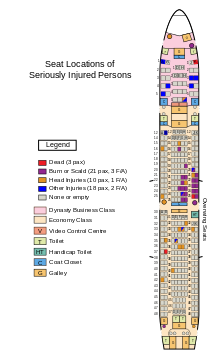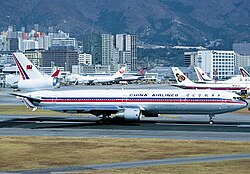ผู้ใช้:ZeroSixTwo/กระบะทราย28
 B-150 เครื่องบินลำที่เกิดเหตุขณะให้บริการกับแมนดารินแอร์ไลน์ที่ท่าอากาศยานไขตั๊ก | |
| สรุปอุบัติเหตุ | |
|---|---|
| วันที่ | 22 สิงหาคม ค.ศ. 1999 |
| สรุป | ตกขณะลงจอดเนื่องจากความผิดพลาดของนักบิน |
| จุดเกิดเหตุ | ท่าอากาศยานนานาชาติฮ่องกง 22°18′18″N 113°55′19″E / 22.305°N 113.922°E |
| อากาศยานลำที่เกิดเหตุ | |
| ประเภทอากาศยาน | แมคดอนเนลล์ ดักลาส เอ็มดี-11 |
| ดําเนินการโดย | ไชนาแอร์ไลน์ (ใช้ลายของแมนดารินแอร์ไลน์) |
| หมายเลขเที่ยวบิน IATA | CI642 |
| หมายเลขเที่ยวบิน ICAO | CAL642 |
| รหัสเรียก | DYNASTY 642 |
| ทะเบียน | B-150 |
| ต้นทาง | ท่าอากาศยานนานาชาติดอนเมือง |
| จุดพัก | ท่าอากาศยานนานาชาติฮ่องกง |
| ปลายทาง | ท่าอากาศยานนานาชาติไต้หวันเถา-ยฺเหวียน |
| จำนวนคน | 315 |
| ผู้โดยสาร | 300 |
| ลูกเรือ | 15 |
| เสียชีวิต | 3 |
| บาดเจ็บ | 208 (44 สาหัส, 164 เล็กน้อย) |
| รอดชีวิต | 312 |
ไชนาแอร์ไลน์ เที่ยวบินที่ 642 เป็นเที่ยวบินจากกรุงเทพมหานครไปยังกรุงไทเปซึ่งประสบอุบัติเหตุขณะลงจอดพักที่ฮ่องกง[1] โดยขณะลงจอดมีพายุไต้ฝุ่นรุนแรง เครื่องบินลงกระแทกพื้น พลิกหงายท้อง และเกิดไฟไหม้ จากผู้โดยสารและลูกเรือบนเครื่องจำนวน 315 คน มีผู้เสียชีวิต 3 คน บาดเจ็บ 208 คน[2] เหตุการณ์ครั้งนี้เป็นอุบัติเหตุร้ายแรงถึงขั้นมีผู้เสียชีวิตครั้งแรกที่เกิดขึ้นที่ท่าอากาศยานนานาชาติฮ่องกงแห่งใหม่หลังเปิดใช้งานใน ค.ศ. 1998[3]
เที่ยวบินที่ 642 เป็นอุบัติเหตุขั้นร้ายแรงที่ทำให้เครื่องบินไม่สามารถซ่อมแซมได้ (hull loss) ของเครื่องบินเอ็มดี-11 ซึ่งเกิดขึ้นเพียงสามครั้งกับเครื่องบินเอ็มดี-11 สำหรับโดยสาร อุบัติเหตุระดับ hull loss ของเครื่องบินรุ่นนี้โดยส่วนใหญ่จะเกิดขึ้นกับเครื่องบินขนส่งสินค้า[4]
เครื่องบินและนักบิน แก้


เครื่องบินลำที่เกิดเหตุเป็นเครื่องบินแมคดอนเนลล์ ดักลาส เอ็มดี-11 ทะเบียน B-150 ซึ่งเข้าประจำฝูงบินของไชนาแอร์ไลน์ใน ค.ศ. 1992 เครื่องบินลำนี้ใช้เครื่องยนต์เทอร์โบแฟนแพรตต์แอนด์วิตนีย์รุ่น PW4460[5]: 13–19 [6][7]
กัปตันเที่ยวบินนี้ได้แก่กัปตันเจราร์โด เลตติก (อิตาลี: Gerardo Lettich) ชาวอิตาลีอายุ 57 ปีซึ่งเคยเป็นนักบินให้สายการบินใหญ่แห่งหนึ่งในทวีปยุโรปก่อนจะเข้ามาเป็นนักบินให้ไชนาแอร์ไลน์ใน ค.ศ. 1997 ก่อนเกิดเหตุเขาสะสมชั่วโมงบินได้ 17,900 ชั่วโมง ในจำนวนนี้ 3,260 ชั่วโมงบินกับเครื่องบินเอ็มดี-11 นักบินผู้ช่วยได้แก่หลิว เชิง-ซี (อังกฤษ: Liu Cheng-hsi) ชาวไต้หวันอายุ 37 ปี เข้าทำงานกับไชนาแอร์ไลน์ตั้งแต่ ค.ศ. 1989 สะสมชั่วโมงบินได้ 4,630 ชั่วโมง เป็นชั่วโมงบินเครื่องบินเอ็มดี-11 2,780 ชั่วโมง[5]: 9–13 [8]
สรุปเหตุการณ์ แก้
ณ เวลา 18:43 น. ตามเวลาท้องถิ่นซึ่งเร็วกว่าประเทศไทย 1 ชั่วโมง คืนวันที่ 22 สิงหาคม ค.ศ. 1999 เที่ยวบินที่ 642 กำลังเตรียมตัวลงจอดที่ทางวิ่ง 25L ในขณะนั้นพายุโซนร้อนกำลังแรงแซมอยู่ห่างจากท่าอากาศยานไขตั๊กประมาณ 50 กิโลเมตร
ขณะเครื่องลงใกล้ถึงพื้น เครื่องบินเอียงไปทางด้านขวา ล้อลงจอดด้านขวากระแทกพื้นอย่างแรงและเครื่องยนต์หมายเลข 3 สัมผัสพื้นทางวิ่ง ปีกด้านขวาหลุดออกจากลำตัวเครื่อง เครื่องบินเอียงลงไปอีก ไถลออกนอกทางวิ่ง และเกิดไฟไหม้บริเวณส่วนท้าย เครื่องบินพลิกหงายท้องและหยุดบนพื้นหญ้าห่างออกจากปลายทางวิ่งประมาณ 3500 ฟุต ปีกด้านขวาอยู่บนแท็กซีเวย์ 280 ฟุต (85 เมตร) จากส่วนหัวเครื่องบิน[9] ความเสียหายส่วนใหญ่อยู่ที่บริเวณส่วนท้ายเครื่อง ไฟที่เกิดขึ้นดับอย่างรวดเร็วเนื่องจากมีฝนตกและเจ้าหน้าที่ตอบสนองอย่างรวดเร็ว
เจ้าหน้าที่กู้ภัยเข้าถึงที่เกิดเหตุและดับเพลิงอย่างรวดเร็ว ทำให้ผู้โดยสารส่วนใหญ่และลูกเรือได้รับการช่วยเหลือแม้ว่าสภาพอากาศจะเลวร้ายก็ตาม ผู้โดยสารสองคนเสียชีวิตหลังนำส่งโรงพยาบาล และอืกหนึ่งคนเสียชีวิตที่โรงพยาบาลห้าวันถัดมา[10] โดยรวมมีผู้โดยสารและลูกเรือที่ถูกนำส่งโรงพยาบาล 219 คน ในจำนวนนี้ 50 คนอาการสาหัส และ 153 คนบาดเจ็บเล็กน้อย ลูกเรือทั้ง 15 คนรอดชีวิต[5]: 7
Investigation แก้
The final report of the accident blamed it mainly on pilot error, specifically the inability to arrest the high rate of descent existing at 50 ฟุต (15 เมตร) altitude on the radar altimeter. The descent rate at touch down was 18–20 ฟุตต่อวินาที (5.5–6.1 เมตรต่อวินาที).
The flight data stored in the volatile memory of the aircraft's Quick Access Recorder (QAR) during the last 500 ฟุต (150 เมตร) of the approach could not be recovered due to the interruption of the power supply at impact. Probable wind variations and the loss of headwind component, together with the early retardation of thrust levers, led to a 20 นอต (37 กิโลเมตรต่อชั่วโมง; 23 ไมล์ต่อชั่วโมง) loss in indicated airspeed just prior to touchdown.[5]
Due to the severe weather conditions forecast for Hong Kong, the flight crew had prepared to divert the flight to Taipei if the situation at Hong Kong was deemed unsuitable for landing. Extra fuel was carried for this possibility, resulting in a landing weight of 429,557 lb (194,844 kg), 99.897% of its maximum landing weight of 430,000 lb (200,000 kg). Based on the initial weather and wind check which was passed along to the crew from Hong Kong during the flight, they believed they could land there and decided against a diversion to Taipei. However, four earlier flights had carried out missed approaches at Hong Kong and five had diverted.
During the final approach, the plane descended along the Instrument Landing System (ILS) glideslope until at about 700 ฟุต (210 เมตร), the crew visually acquired the runway. They disengaged the autopilot but left the autothrottle on. During the flare, the rate of descent was not arrested, the plane landed with the right wing slightly lower. The right landing gear touched down first, the right engine impacted the runway and the right wing was detached from the fuselage. Since the left wing was still attached, the lift from that wing rolled the fuselage onto its right side, and the plane came to rest inverted in the grass strip next to the runway. The spilled fuel caught fire.[5]
Several suggestions were given to China Airlines concerning its training.[5] However, China Airlines disputed the report's findings on the flight crews' actions, citing the weather conditions at the time of the accident and claimed that the aircraft flew into a microburst just before landing, causing it to crash.[11]
Aftermath แก้
As of 2016 the route continues to operate with the flight no longer originating in Bangkok and is strictly a Hong Kong-Taipei route. Bangkok-Hong Kong service ended on 31 October 2010. Both non-stop routes are now flown by the Airbus A330-300.[12]
Media แก้
The landing and crash of Flight 642 was recorded by nearby occupants in a car. The video, which also captured reactions from the witnesses, has been uploaded to websites such as YouTube and Airdisaster.com.[13]
A photo showing another Mandarin Airlines MD-11 taxiing past the remains of Flight 642 was circulated.[14]
This disaster was also aired on RTHK's Elite Brigade II Episode 2 in 2012.
ดูเพิ่ม แก้
- Martinair Flight 495 – a DC-10 that broke up after a hard landing under similar weather conditions in 1992
- Lufthansa Cargo Flight 8460 – an MD-11 that bounced and broke up on landing in 2010
- FedEx Express Flight 80 – an MD-11 that bounced and flipped on landing in 2009
- FedEx Express Flight 14 – an MD-11 that bounced and flipped on landing in 1997
- List of accidents and incidents involving commercial aircraft
อ้างอิง แก้
- ↑ Murphy, Colum (5 February 2005). "Pilot error blamed for typhoon crash". The Standard. คลังข้อมูลเก่าเก็บจากแหล่งเดิมเมื่อ 27 March 2009. สืบค้นเมื่อ 28 May 2011.
- ↑ Ranter, Harro. "ASN Aircraft accident McDonnell Douglas MD-11 B-150 Hong Kong-Chek Lap Kok International Airport (HKG)". aviation-safety.net. Aviation Safety Network. สืบค้นเมื่อ 2019-07-10.
- ↑ "Sunday's Hong Kong crash fourth accident in past decade". CNN. Reuters. 1999-08-22. สืบค้นเมื่อ 2020-03-01.
- ↑ Ranter, Harro. "MD-11 hull losses". aviation-safety.net. Aviation Safety Network. สืบค้นเมื่อ 2019-07-10.
- ↑ 5.0 5.1 5.2 5.3 5.4 5.5 "Report on the accident to Boeing MD11 B-150 at Hong Kong International Airport on 22 August 1999" (PDF). www.cad.gov.hk. Hong Kong: Civil Aviation Department. December 2004. สืบค้นเมื่อ 2016-05-31.
- ↑ "B-150 China Airlines McDonnell Douglas MD-11". www.planespotters.net (ภาษาอังกฤษ). สืบค้นเมื่อ 2020-03-01.
- ↑ "China Airlines B-150 (McDonnell Douglas MD-11 - MSN 48468)". www.airfleets.net. Airfleets aviation. สืบค้นเมื่อ 2020-03-01.
- ↑ Lee, Ella; Lee, Stella (1999-09-22). "Pilots urged to attend meeting with Taiwan aviation heads". South China Morning Post. สืบค้นเมื่อ 2020-03-01.
- ↑ "Accident Bulletin on China Airlines". www.info.gov.hk. สืบค้นเมื่อ 2016-05-31.
- ↑ "2 die, more than 200 hurt in Hong Kong jet crash". CNN. 1999-08-22. สืบค้นเมื่อ 2020-03-01.
- ↑ "China Airlines Disputes Official Finding of Pilot Error". www.defensedaily.com. Defense Daily. 14 February 2005. สืบค้นเมื่อ 2020-03-01.
- ↑ "China Airlines (CI) #642". FlightAware. FlightAware. สืบค้นเมื่อ 2016-05-31.
- ↑ "Airdisaster.com video of Mandarin Airlines Flight 642". Airdisaster.com. คลังข้อมูลเก่าเก็บจากแหล่งเดิมเมื่อ 9 December 2003. สืบค้นเมื่อ 2020-03-01.
{{cite web}}: CS1 maint: unfit URL (ลิงก์) - ↑ "A Difficult Cabin Announcement". Snopes.com (ภาษาอังกฤษแบบอเมริกัน). สืบค้นเมื่อ 2020-03-01.
แหล่งข้อมูลอื่น แก้
| Pre-crash photos of B-150 | |
- Civil Aviation Department
- (ในภาษาอังกฤษ) Video of the incident ที่ยูทูบ
- (ในภาษาสเปน) Video of the incident ที่ยูทูบ
- Li, Alex Fu-hing. "Air crash rescuers praised for courage and gallantry". Civil Service Bureau. คลังข้อมูลเก่าเก็บจากแหล่งเดิมเมื่อ 4 December 2000.
? แก้
การมองเห็นเริ่มต้นของแม่แบบนี้ ปัจจุบันมีค่าเริ่มต้นเป็น autocollapse หมายความว่า หากมีวัตถุอื่นที่มีคุณลักษณะยุบได้วางอยู่ในหน้า (navbox, sidebar หรือตารางที่ยุบได้) แม่แบบนี้จะถูกซ่อนให้เหลือแต่แถบชื่อเรื่อง หากไม่มี ก็จะสามารถเห็นได้ทั้งหมด
ในการตั้งค่าการมองเห็นเริ่มต้นของแม่แบบนี้ ให้ใช้พารามิเตอร์ |state= ดังนี้
{{ZeroSixTwo|state=collapsed}}จะแสดงแม่แบบนี้ในสภาพยุบ กล่าวคือ ถูกซ่อนให้เหลือแต่แถบชื่อเรื่อง{{ZeroSixTwo|state=expanded}}จะแสดงแม่แบบนี้ในสภาพขยาย กล่าวคือ สามารถเห็นได้ทั้งหมด
แม่แบบ:Administrative divisions links
| ผู้เขียนสามารถทำการทดลองได้ที่กระบะทราย (สร้าง | คัดลอก) และชุดทดสอบ (สร้าง) ของแม่แบบนี้ หน้าย่อยของหน้านี้ |